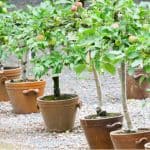Last updated on April 28th, 2022
Our site is reader supported, this means we may earn a small commission from Amazon and other affiliates when you buy through links on our site.
While most palm trees need tropical temperatures there are a few that are suitable for planting outdoors in the UK. One of our personal favourites is the Trachycarpus forunei but Phoenix canariensis is also a popular choice and can often be seen in many gardens throughout the UK. These palm trees can add a lot of structure to your garden and really give it that tropical feel.
- TROPICAL LOOK: These tropical, architectural beauties will add a holiday feel to your patio for years to come!
- DRAMATIC PLANTS: With spectacular fan-shaped foliage, Phoenix palms provide dramatic impact to any garden. During a hot summer these plants may produce creamy-yellow flowers.
- SUNNY POSITION: These evergreen palm trees love sunny positions in the garden and will be perfect in patio pots. A real go-getter in UK gardens, reaching a mature height around 1.5m in time.
- DETAILS: Supplied as a pair of established plants, approximately 55-75cm tall in 14cm pots, ready to plant.
- ABOUT US: At YouGarden, we believe that gardening is for everyone. Based in rural Lincolnshire we have our own 11 acre nursery, meaning that we are in close contact with our plants, so that we can guarantee our plants will thrive because we've grown them ourselves. We also source product locally, nationally and internationally to ensure we give our customers the best range, highest quality and greatest value for money. All our products will arrive in nursery fresh condition.
- HARDY PALM TREE - Trachycarpus is one of the most hardy palm trees available. It's able to survive down to -10°C so is ideal for growing in the variable British climate.
- EXOTIC LEAVES - With its deep-green, tough, fan-shaped leaves this exotic beauty will be a brilliant tropical centrepiece wherever you decide to plant it.
- SLOW GROWING - It is slow-growing and compact, ideal for a large patio pot, or alternatively you could plant it directly in the ground in a sunny spot. Winner of a prestigious RHS Award of Garden Merit.
- CARE - Cut off the leaves when they turn brown and over time, an upright, woody, fibrous trunk will be formed. Best grown in a sunny, sheltered spot.
- DETAILS - Supplied as an established potted plant, already approx. 50-55cm tall (including pot), Trachycarpus will grow around 5-10cm a year.
Where can you grow hardy palm trees?
Hardy palm trees, such as the two varieties mentioned above, will survive winters in much of the south of Britain if they are given sheltered conditions although you can often spot established palm trees further north, such as in the North West, in cities such as Manchester.
However, plants that are grown in exposed areas or in containers are more liable to be damaged during the winter, which is why you should always find a hardy specimen that is less likely to be damaged. Give them some extra protection in winter by bringing them into a cold greenhouse, at least until it’s fully established with a good root system, at which point it will be suitable for planting in the ground. Even further south though, we recommend growing them in pots until there is a good-sized root system before planting them permanently in the ground.
Choosing the right compost
You can grow palm trees in containers with the right compost but make sure that you bring them undercover for the winter and work to improve drainage conditions by making sure they have ample drainage holes and plenty of crockery in the bottom of the pot to prevent the holes from becoming blocked.
Soil-based compost, such as John Innes potting compost, is perfect because it helps to retain moisture, and being a heavier medium also helps keep the pots upright in the wind.
- 8 weeks nutrition
- Beautiful, decorative leaves
- A lot of water
- Model number: 1143102004
Improving clay soil
On the note of drainage, if you have heavier clay soils these are much more prone to waterlogging so they won’t work as well for the palm trees. That being said, if you add plenty of grit to the soil to improve drainage and then lift the soil to the surface with some extra compost and form a mound, you can plant the palm tree with some of the roots above the original ground level so at least some of the root system is not as prone to waterlogging, and this may be enough to help it thrive. Failing this, the only option will be to grow them in containers and pots.
Allow plenty of space for them to spread
Keep in mind that palm trees grow very slowly. Despite their slow growth rate, they need a lot of space so don’t plant them near other shrubs or flowers in your garden that will try to compete for resources.
Plant them in a bright position with plenty of light

Even if you do have a mild winter, remember that palm trees are not tolerant of a lot of shade so you will need to put them in a location where they will receive an ample amount of sunlight.
Winter protection – bring them indoors or cover them with fleece if you have a younger plant
As palm tree stems thicken with age they become more tolerant of lower winter temperatures but during the first few years, you should always protect the containers, bringing them indoors during the winter into a cold greenhouse or conservatory if possible. The first few years are when they are most at risk from cold temperatures until they establish a good root system.
If this is not possible wrap the containers in lagging to protect the root system and cover the plants with a couple of layers of fleece or use a fleece jacket if the temperatures are forecasted to drop below freezing. Larger established plants ground in the ground are usually fine.
- Provides instant protection from frost and harsh weather, while still allowing air and moisture to filter through to maintain healthy growth
- Made of soft-green, high-quality UV-stabilized, extra thick 35gsm polypropylene fleece; includes drawstring for easy and practical use.
- Two jackets per pack; Dimensions: 47"D x 71"H each
- Ideal cover for wintering large, exotic, and tender container plants such as palms and cordalynes; eliminates the need for bring indoors
- Also available in Small and Medium sizes (sold separately)
Pruning palm trees
Unlike other trees, you don’t actually need to prune a palm tree. However, you can always remove the lower leaves when they start to die off and become unsightly. If you are doing this, it’s important you don’t cut them right back to the main stem and leave a little still attached.
Propagation palm trees
Palm trees are generally propagated by seed but some can be divided. This is done by dividing the suckers and replanting these, this is usually an option for Chamaerops. Dividing is a much faster process than trying to propagate by seed.
The seeds should be planted to their own depth and it’s better to use fresh seeds and placed them in a heated propagator. They will typically sprout within one or two weeks but they can take up to a few months to properly germinate and can also take a few years to be appropriately sized for transplantation, so it’s a slow process.
Common Problems (winter damage)
Palm trees are very strong and they don’t incur a lot of problems with diseases or pests. Realistically the biggest issue you’re going to face is winter damage. This can be a real problem, especially in colder parts of the UK.
If winter damage does take place you should remove any of the damaged growth in the spring and make sure the soil conditions are appropriate for recovery.
We are often asked if a palm tree has died when no new growth has appeared by summer. The answer is usually yes because they can only grow from the top of the trunk and cannot regrow from the base like some trees.
Recommended hardy palm trees to consider
- Trachycarpus forunei (Chusan palm)
- Dwarf fan palm (Chamaerops humilis)
- Caranday Palm (Phoenix canariensis)
- Washington Palm (Washingtonia filifera)
Last update on 2025-07-05 / Affiliate links / Images from Amazon Product Advertising API






